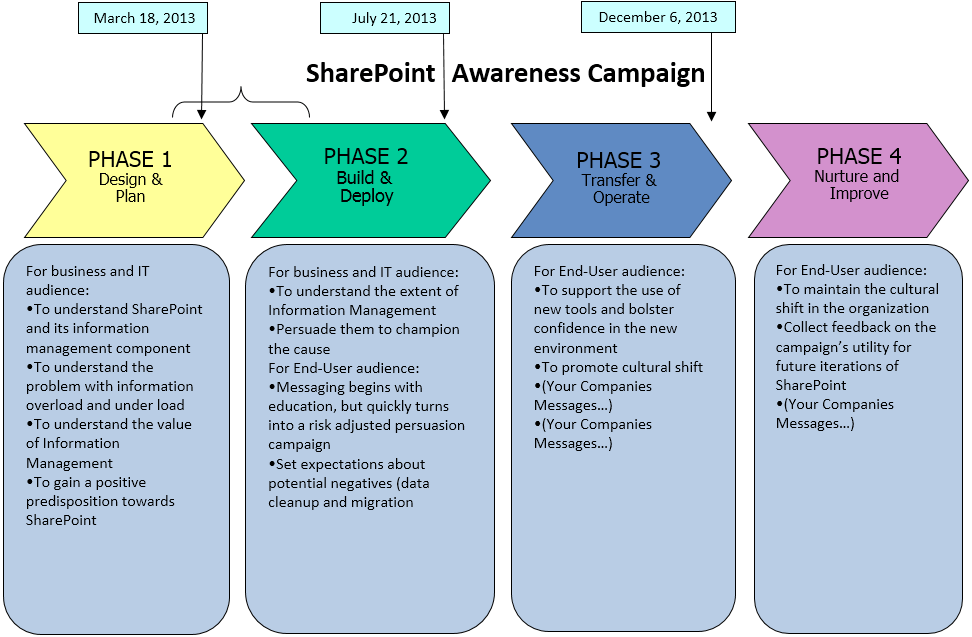For most companies, upgrading to SharePoint 2013 is accompanied by lots of uncertainty and fear. Uncertainty is coupled with questions such as “Will our site collections work in 2013?” or “How long is this going to take?” The risks associated in cascading a new technology company-wide is another issue that executives have to address. For instance, the problem of downtime, incompatibilities, and staff learning curve are all negative scenarios that must be faced well prepared.
One of the solutions to have a smooth SharePoint migration is through building a SharePoint internal communication plan. Errin O’Connor in his CMS Wire article brings us step-by-step to the process. Essentially, Errin recommends that a SharePoint 2013 migration plan should have a continuous communication and PR campaign that is segmented by phase. Each phase must have its own objectives targeting specific stakeholders that are critical to SharePoint 2013 upgrade success. On her example, she segmented migration into four phases.
Image courtesy of CMS Wire
The diagram shows four phases that SharePoint 2013 internal communication plan must undergo. Note though that the communication plan must be tightly knitted with the company’s SharePoint Governance Plan. Don’t know what SharePoint governance is? Learn more here.
First Phase
Initially targeting business and IT stakeholders, the first phase of the communication plan aims to inform. The end goal is to gain employee buy-in, a state where people in the organization understand themselves the importance of upgrading to SharePoint 2013; and they all want to do their part to make it a success.
Translating this into action items, it means that the first phase involves a lot of information campaigns. Educating relevant stakeholders about SharePoint 2013 can be done through workshops, seminars, webinars, presentations or email campaign drives to get the point across.
Second Phase
Once stakeholder buy-in has been achieved, the next phase is all about doing the hard work – the upgrade itself. The upgrade to SharePoint 2013 can be done as an internal project or can be outsourced to experts who are more experienced in doing migration. Whether it is an internal or an outsourced endeavor, it is important to have a separate communication plan for this.
For most parts it is important to have:
- A detailed project scope of work, where all the details of the migration are laid-down;
- The risks involved in doing the SharePoint 2013 upgrade and what can be done to mitigate those risks;
- A clear segmentation of roles and what are their corresponding responsibilities for the migration; for instance identify the decision maker for database migration, infrastructure set-up, scope of work and costs; and
- A timeline identifying all the milestones and the final roll-out of the upgraded SharePoint 2013 platform.
Third Phase
Completing the migration is not the end of the communication plan, obviously. The third phase is perhaps one of the most challenging parts – as this one directly impacts frontline operations. Cascading the upgraded SharePoint 2013 platform involves training, seminars and workshops to ease the learning curve for each employee.
It is important that users understand the new features and encourage them to use the platform; otherwise all efforts will go down the drain.
Fourth Phase
SharePoint 2013 communication plan should be a continuous process – much like the organization itself, the platform should be thriving and adapt to the needs of its users. Encourage people to escalate issues, bugs or improvements that they want for the app. It is also ideal to persuade the use of SharePoint 2013’s social functionalities as it fosters a collaborative and fun environment. Take advantage of its gamification, social, feeds and other communication aspects.
Upgrading to SharePoint 2013 shouldn’t be much of a problem if you have experts working with you through-out the way. Contact an expert at Portal Integrators today.

